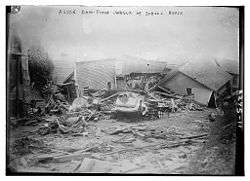Austin Dam
Austin Dam was a dam in the Austin, Pennsylvania area that served the Bayless Pulp and Paper Mill. A failure of the dam on September 30, 1911 caused significant destruction and loss of life in the valley below.
| Austin Dam | |
|---|---|
Remnants of Austin Dam in 2008. | |
| Location | Keating Township, Potter County, near Austin, Pennsylvania |
| Opening date | December 1909[1] |
| Demolition date | September 30, 1911[1] |
| Operator(s) | Bayless Pulp & Paper Company |
| Dam and spillways | |
| Impounds | Freeman Run |
| Height | 50 feet (15 m)[1] |
| Length | 540 feet (160 m)[1] |
| Reservoir | |
| Creates | Austin Dam Pool |
| Total capacity | 200,000,000 US gallons (760,000,000 l)[1] |
Austin Dam | |
 School house after dam disaster | |
  | |
| Location | PA 872, Austin, Pennsylvania |
| Coordinates | 41°39′11″N 78°5′8″W |
| Area | 1.3 acres (0.53 ha) |
| Built | 1911 |
| Built by | Hatton, T. Chalkey |
| NRHP reference No. | 86003570[2] |
| Added to NRHP | January 15, 1987 |
History
In 1900, Bayless Paper chose to construct a paper mill in the Freeman Run Valley. By 1909, the company realized that occasional dry seasons required a more reliable water source. After finding a small earthen dam to be inadequate, the T. Chalkey Hatton firm built a large concrete dam across the valley. The dam was 50 feet (15 m) high, 540 feet (160 m) long and cost $86,000 to construct.[1] It was designed to be thirty feet thick, but was built only twenty feet thick.[3]
Within only a few months of its completion, problems were detected. The dam bowed more than 36 feet (11 m) under the pressure of the water it was holding and the concrete started cracking. The bowing was alleviated by using dynamite to blast a 13-foot (4.0 m) space for the excess water to spill over. The cracking was claimed to be normal because of the drying cement.
On September 30, 1911, the dam failed and destroyed the Bayless Pulp and Paper Mill as well as much of the town of Austin. The damage was approximately $10 million. It also resulted in the deaths of 78 people. A young girl named Mary Fran Simmons, a new immigrant from Galicia, warned many of the townspeople about the impending disaster with her extremely limited English, simply pointing and repeating, "Dam! Dam!" The paper mill and dam were subsequently rebuilt, but the mill was lost in a fire in 1933. The new dam failed in 1942 with no loss of life. The dam was not replaced after the second failure.
Legacy
The ruins consist of a series of broken sections extending east to west across the Freeman Run Valley. There are five upright sections and two large and several smaller toppled sections.[4] The site was added to the National Register of Historic Places in 1987.[2]
A documentary about the dam disaster, featuring narration by Willie Nelson, was created by Mansfield University of Pennsylvania professor Gale Largey in 1999. It includes interviews with five survivors along with original newsreel footage.[5]
External links
- Austin (Bayless) Dam failure case study at the Association of State Dam Safety Officials
- Austin Dam from the Library of Congress at Flickr Commons
| Wikimedia Commons has media related to Austin Dam. |
References
- Wise, Eric (September 2005). "The Day Austin Died" (PDF). Penn Lines. Harrisburg, Pennsylvania: Pennsylvania Rural Electric Association. 40 (9): 8–11. Archived from the original (PDF) on 2009-09-20. Retrieved 2009-09-19.
- "National Register Information System". National Register of Historic Places. National Park Service. July 9, 2010.
- "Flaws in Austin Dam. Only Twenty Feet Thick, Though Plans Called for Thirty". The New York Times. October 31, 1911. Retrieved 2010-11-07.
The recent disaster at Austin. Penn., resulted from alleged failure to carry out the original plans for the construction of the dam, according to a statement given out to-day by the State Conservation Commission.
- "National Historic Landmarks & National Register of Historic Places in Pennsylvania" (Searchable database). CRGIS: Cultural Resources Geographic Information System. Note: This includes Robert K. Curren and William Sisson (October 1986). "National Register of Historic Places Inventory Nomination Form: Austin Dam" (PDF). Retrieved 2012-05-30.
- Largey, Gale. "The Austin Disaster 1911: A Chronicle of Human Character". Retrieved 2009-10-30.

